
Permanent Way News Archive : May-Aug 2003
All the pictures on this page are thumbnail views - click on them to see the full picture.

Permanent Way News Archive : May-Aug 2003
All the pictures on this page are thumbnail views - click
on them to see the full picture.
News Report:
11th August 2003
The last few Sundays have seen general maintenance undertaken at various points along the line. The 13th of July was another sweltering summer day, resulting in a limited amount of work being done before the rail temperature exceeded the safe working limit as early as 10.30am! However, we still managed to put in a useful hour and a half of work tackling our old favourite misalignment at the south end of number 3 road at Horsted Keynes. Our early morning task the following week was to replace five rotten sleepers south of Holywell waterworks, which had to be done in stages between the passing of two light engines towards Horsted Keynes.
The replacement sleepers had been delivered to site by Paul Robertson, our P-way manager, during the previous week, and so we only had to offload tools and ourselves from the Wickham, which was kindly driven to site for us by Charles Hudson of the S&T department. Despite the work being completed before the start of the timetabled service, there was no path available for the Wickham to come and return us to Horsted Keynes, so we spent a pleasant hour clearing ballast from sleepers, making general lineside improvements, and observing buzzards circling over Medhurst farm. The 12pm ex. Sheffield Park made a special stop to return us to Horsted Keynes, an d with tools and men quickly loaded, No.75027 soon accelerated the train on its way again.
Left: The fishplate team working at the north end of the tunnel. Centre: The packing team go in search of their next dipped joint (both Jon Goff). Right: Applying the subtle approach to a stubborn fishplate bolt (Jon Bowers).
The afternoon was spent preparing for the coming Wednesday evening working session in Sharpthorne tunnel, preparations which w ere continued on the Wednesday afternoon itself. The latter quickly developed into a 'hunt the generator' exercise, which was found at the last minute to be lurking in the C&W chippy shop! With Graham Ward driving, the Wickham set off for the tunnel a little after 5pm, proceeding to West Hoathly to collect the rest of the workforce. Work then got underway, with Graham leading one team southwards through the tunnel packing the worst of the joints, while the rest of us began se rvicing the fishplates. This involved checking for signs of fatigue in the plates and bolts, replacing if necessary, or just re-greasing and refastening. Working from the north end, about a quarter of the fishplates were serviced in this way, and so another evening session in the tunnel is being considered for a few weeks time to tackle the remainder. The age range of the attendees was from 13 to 70, and so all levels of fitness and expertise were catered for.
The following Sunday saw us making an early morning Wickham journey up the line to deposit chippings at New Coombe bridge for work in the coming weeks, before returning to Horsted to tackle No.4 road just north of the station entry points.
A number of people have asked us about progress, or rather the lack of it, on the Ardingly project which started at the beginning of the year. It had been hoped that a few events could be held to celebrate the anniversaries of both the opening (1883) and closing (1963) of the Ardingly branch, possibly a short shuttle from the station using Fenchurch and the Queen Mary Brakevan on a new 'siding'. Indeed, the former siding was successfully slewed over to the west side of the formation in March by a volunteer team of up to 20 people in order to make space for the new line. However, the project has now been called off for the time being, for a number of reasons.
Any train carrying passengers (even if just a brakevan ride) would need to meet the same safety regulations etc. as on the main running line, and thus b e laid and maintained to a high standard. Add to that the fact that a very large amount of spoil making up the embankment between the end of the current spur and the remains of Sherrif Mill viaduct is/ would be required for any future extension to Ardingly, and laying a new line on the spur would complicate vehicle access for this purpose. Also, the new line would have used the former national network flat-bottom rail plated wooden sleepers that took many volunteer working days to pr epare for the purpose.
Since this came just after the railway had re-structured its full time p-way staff, and the volunteers, when available, maintain the top and alignment, it was important not to let routine maintenance fall behind schedule due to processing of sleepers. The fact that the line actually goes downhill quite steeply from Horsted Keynes brings further complications, and although you could always raise the level up to the viaduct or install a catch point, this is all extra expense at a time that the railway is concentrating on Woodpax and East Grinstead. Also, with FOK volunteers being involved with the extension northwards, the overhaul of the Queen Mary brakevan intended to be used on any shuttles has also fallen a little behind schedule.
A few other reasons also spring to mind but those are the main ones, and so it was decided that the project be postponed for the time being. However, the effort of p rocessing around 350 wooden sleepers will not be wasted though, since the current extension plan means they are to be used on the first stretch northwards from Kingscote as far as the Turners Hill road bridge, with concrete sleepers for the remainder of the section, excluding the viaduct.
On a positive note, the gang attendences continue to rise, despite the recent hot weather. As always, new volunteers will be made very welcome, so why not come along and give us a try for a day? In addition, we are looking into the possibility of an exchange visit with P-way volunteers from the Mid Hants railway in late September, to exchange ideas, working practices, stories etc.
News Report: 11th July 2003
by Jon Bowers and Paul Norris
Despite the lack of news reports recently, plenty of routine maintenance has been undertaken, with the P-way gang out a nd about most Sunday's in May and June. Regrettably, Graham Ward has had to step down from his position as leader of the volunteer meetings due to health reasons, though he will continue his work in the Carriage and Wagon department. His leadership skills and knowledge will be greatly missed, and I'm sure we all wish him the quickest possible recovery. He will still help us out from time to time though, such as driving the Wickham trolley for the forthcoming tunnel maintenance evenin g, but more on that later.
The first Sunday in May saw the P-way gang back out on the main running line, working to correct two slight misalignments that had been developing at Kingscote. First to be tackled was one at the northern end of the run-round on the loop line, which required jacking up and shovel packing of ballast to restore the correct cant. The section was checked again towards the end of the day to see if the passage of locomotives running round thei r trains had caused any further movement, but all proved to be OK.
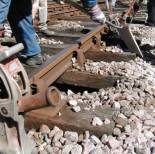
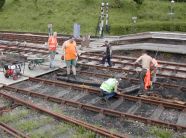
Left: Shovel packing to restore the correct cant at Kingscote on Sunday 4th May 2003. Right: Replacing old sleepers in Horsted Keynes yard.
In the afternoon we were able to turn our attentions to the other problem section between the advanced starter and home signals. Work involved a combination of stone blowing and packing chippings right the way up to Kingscote signal cabin. Two weeks later the stone blower was in use again, this time at Horsted Keynes, where work was undertaken on every joint from the points at the southern entrance to the station to New Road bridge. The following week saw us working in the sidings at the northern end of Horsted Keynes, changing old and rotten sleepers.
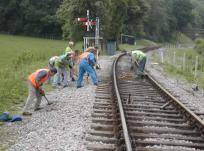
Above: Work in progress to correct a buckle at Leamland Junction.
Before the first train on the 1st June, the gang headed up to just north of 'Leamland junction' to correct a buckle that had been developing in the hot weather of the previous day. This involved slewing with the hydraulic jacks, followed by much packing. An early tea was taken in the carriage works while the first trains of the day passed over it, then some of the gang headed back northwards to check all was well. Meanwhile, the rest of the gang carried on from two weeks previously, lifting joints southwards from New Road bridge. A number of joints were tackled to the south side of the Three Arch bridge, the digging out being difficult due to the presence of wet clay. This was traced to a blocked under-track drainage pipe, presumably damaged by the tamper. Thus new drainage channels were dug and the existing ones improved, while the pipe in question was rodded the next week.
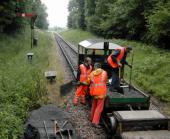
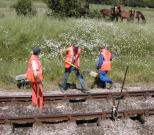
Left: Unloading chippings at Ketches Halt, 8th June 2003. Right: Working under observation near Sheffield Park.
The second Sunday in June saw us working just to the north of Sheffield Park, along Ketches straight. Almost every joint needed some attention, and yet aga in our favourite mixture of water and clay did its best to hinder our progress! Even so, we managed to get to the Sheffield Park end of the straight before running out of chippings. Shortly after the departure of a northbound Golden Arrow working, an unusual treat was being 'buzzed' by the Red Arrows, presumably on their way to the Biggin Hill air show.
Early June also saw midweek sleeper changing at Sheffield Park, undertaken by John Padgham and some mid-week vo lunteers, where the timbers at the northern points controlling the entrance to the station from the single line were replaced. Meanwhile, north of the buffer stops at Kingscote on the East Grinstead extension, John Milham has started the drainage work, attended to a slip north of the second Turners Hill road bridge, and begun the excavations for a signal post.
The last two weekends in June saw little undertaken due to the extensive service of the Thomas weekends. However gang members were available on both weekends as a standby incase called on for emergency track work. Everything went sm oothly however, and we enjoyed the shunting displays and races between 'Percy' and northbound departures from Horsted Keynes. A little bit of work was done though, preparing fishplate bolts for work in the coming weeks.
And so the first Sunday in July arrived. One job could have been to tackle some sheep that had escaped onto the line just north of the Ouse bridge at Sheffield Park, but although the signalman at Horsted had informed us that Dave Phillips was a lready herding them, we could not help as there was no Wickham trolley driver available.
Thus the waterlogging problems mentioned previously at the joints south of Three Arch bridge were re-visited, and we returned to this spot to find the track had dried out, but that the under line drainage pipe which had been damaged accidentally by the tamper was still blocked. How the problem was tackled is described with the photo below, and it is hoped that tampers, fl ails and similar machines will not damage either of the drainage pipes in the future. Meanwhile the midweek teams continue to paint the mileage and gradient posts, tidy banks and keep culverts cleaned, and it is hoped that the 'insect men' will include these on their inspections.
A broken chair on the mainline just south of Horsted Keynes was also changed just prior to lunch. Afterwards, we decided to inspect a slight imperfection, which had been reported near to the cottages at Holywell water-works. This was a welcome chance for the chaps to inspect a different area and for our expertise and recognition of safe working practices to be implemented and tested to the full. At the end of the day, it was nice to sample the delights of Mrs Blotís wonderful cake and have tea in the C&W mess room and exchange stories with the volunteers there as well.
In addition to the usual Sunday meetings planned for the coming weeks, the p-way gang will be giving Sharpthorne tunnel its annual summer examination and maintenance session on the evening of Wednesday 23rd July after the last train has been through. It's nice and cool (and damp...) in there in the summer and is a very different working environment from normal, even without trains passing through. Since access is nor mally out of bounds, this is a rare opportunity to experience the longest tunnel on a preserved railway away from the carriage window and get some exercise and help the railway at the same time. There is a lot of work to be done, so all help would be greatly appreciated, even if you can only spare an hour or two. If you're free that evening (and a current Bluebell member), please email us at bluebellpway@tiscali.co.uk. We must emphasise that the tunnel is strictly out of bounds under normal circumstances (including during the daytime running of the Wednesday) and that the evening is a working session - we aren't running guided tours !!
Click here
to go back to the main Permanent Way news page.
![]()